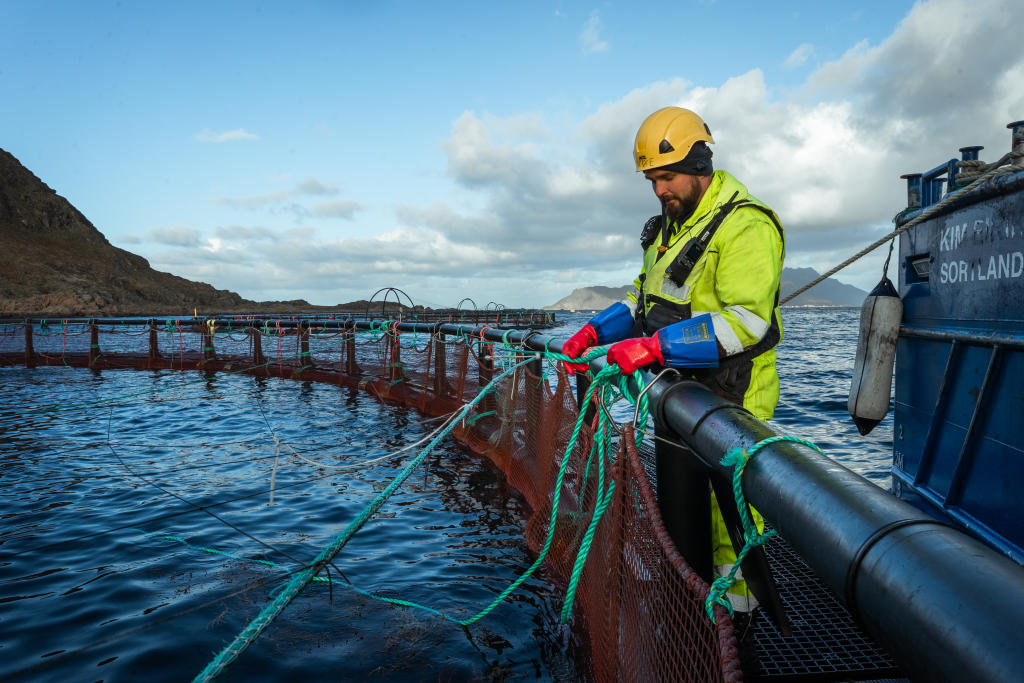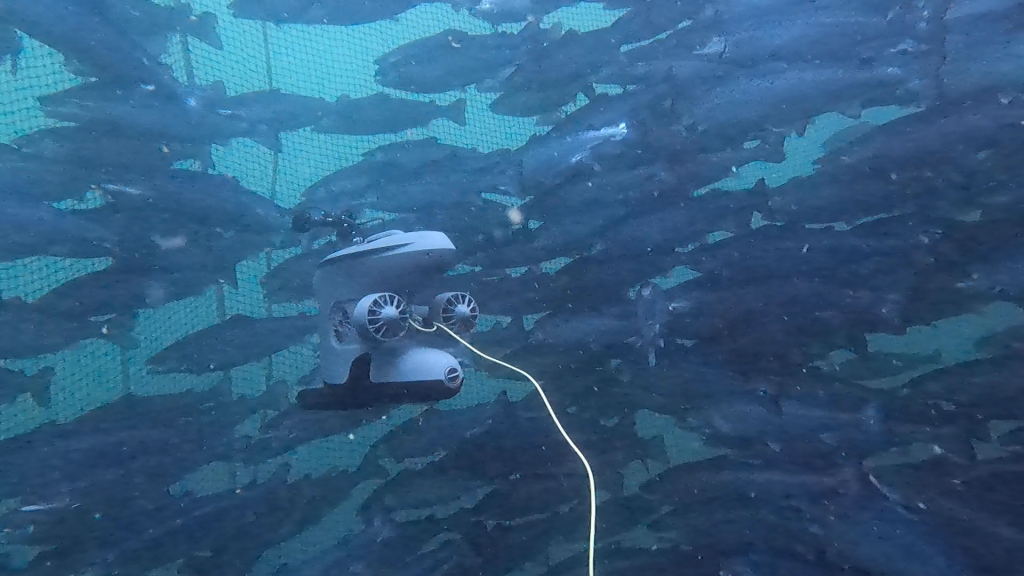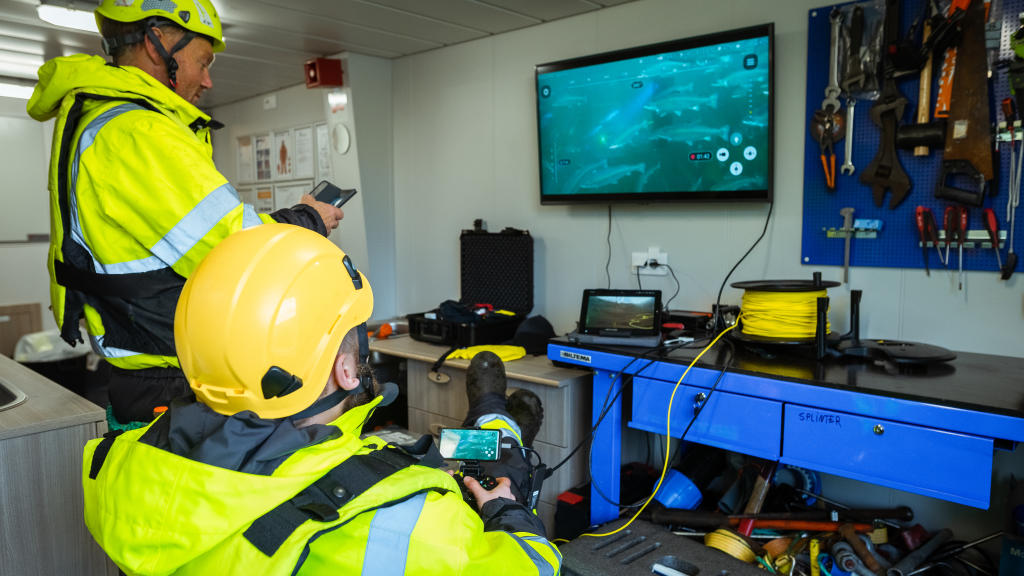There are essentially five different methods of delousing that are used in Norway
Salmon lice are monitored and counted weekly at the fish farm. Daily measures are also taken against salmon lice, such as cleaning fish, lice lasers, and lice skirts. During certain periods of the year, the lice thrive better and reproduce faster, and then the breeders must resort to more extensive methods, such as handling the fish to keep the salmon lice away.
The most common delousing operations today are:
- Thermal disinfection
- Mechanical delousing removal
- Freshwater in a well-boat
- Freshwater lid in a cage with skirt
- Chemical extermination
We are using the Blueye Pioneer to follow up and control our fish. With the underwater drone we are able to control fish welfare, fouling on fish nets and general supervision of our underwater assets. -Johannes Schrøder, Salmar
Thermal delousing
Thermal delousing is the most common delousing method according to FHF (Fiskeri og Havbruknæringens Forskningsfinansering), where salmon are exposed to seawater at 28-34 °C for approx 20-30 seconds on board a vessel or fleet (fhf.no). The lice removal mechanism takes place by rapidly heating up moving lice so that the muscles are paralyzed, and the lice lose their ability to attach to the skin surface, and fall off. The exposure to warm seawater must be so short that the fish does not heat up, so the thermal effect works primarily on the lice (fhf.no).

Mechanical delousing
Three commercial methods are used for mechanical delousing: SkaMik, FLS delousing system, and Hydrolicer (fhf.no). With SkaMik, for example, the fish is pumped on board a vessel (such as a well boat) and filtered before it goes through a flushing chamber. The fish is then passed through a rotating brush chamber before returning to the cage.

Fresh water in a well-boat
Today, many farmed fish are exposed to fresh water through well-boats for delousing. This treatment usually takes place for four to eight hours before the fish are strained and returned to the cage. This method is used to disrupt the osmotic balance of salmon lice, which are basically iso-osmotic to the environment. This causes paralysis and eventually death for the lice (fhf.no).
Freshwater lid in a cage with skirt
This method aims to control parasites using fresh water, in the same way as using fresh water in a well boat (fhf.no). Freshwater bathing takes place directly in the cage by pumping fresh water into a cage enclosed by a waterproof skirt. The freshwater will naturally drift to the surface, forming a "lid". The method does not involve the use of drugs or chemicals and reduces the handling of fish as you avoid pumping fish.
Chemical extermination
A final form of delousing that is used to a lesser extent today is chemical delousing. A good deal of research has been done on the environmental effects of the chemicals, and research carried out by NORCE, Akvaplan-Niva, and the Marine Research Institute has shown that chemical lice remedies (bath products) also affect species other than salmon lice (akvaplan.niva.no). It has also been shown that delousing can cause mortality among shrimp.
In Norway, medicinal treatment takes place in two ways: by bathing with the lice remedy and adding the lice remedy to the feed. After the chemical treatment of the salmon, the bath treatment water is discharged into the sea, while lice agents from feed sediment together with surplus feed.

This is how you ensure optimal use of the ROV during desalination operations
According to a major study carried out by SINTEF Ocean, holes in the net because of operations, storms, and the like were the cause of escaped salmon in as many as 75% of the cases of escape in the period 2010-2018 (Sintef, Knowledge, and methods to prevent escape, 2019). In one of five measures proposed in the report, paying attention during crowding and delousing operations is important for preventing escape.
An ROV can be an important contribution to preventing damage to nets. During operations such as delousing, it is therefore important to carry out a visual inspection of the facility after operations, precisely to uncover any damage that could lead to the escape of fish.
With ROVs, you can observe the behavior of the fish during and after delousing, as well as when it is released back into the cage. You can also observe the amount of fish that die and fall to the bottom of the net during and after the shut-off operation.
Underwater ROVs are also used to assess behavior and fish health before a delousing operation, as well as check that any cleaning fish have been fished out of the cage before a de-lice operation starts.

In conversations with various aquaculture actors, we have come up with these tips for optimal use of ROVs during delousing operations:
Preparation:
- Check that all the equipment including the phone/tablet, is fully charged, that the software on the phone and drone is updated and that there is free storage space on the ROV.
- Plan which dives you will do, where, and when. How long time do you expect to spend? Where should the ROV be in the water for the best overview of the desalination process? How to avoid obstacles and dangers such as the balls, discharge grooves, pumps, and return hoses. And finally, find a safe place to run the ROV from.
- An agreement with a colleague about helping to monitor various screens, especially if more than one camera is used on the ROV. This distributes the inspection work and minimizes the risk of overlooking damage.
- Check that the ROV and the equipment work as expected. Do you need to recalibrate the compass?
- Inspect the cages and equipment in the water before the delousing starts to verify that everything looks fine and that any cleaning fish have been fished out. Here, it is particularly important to look for foreign elements that can get stuck in the delousing equipment during penetration and make holes in the bill.
During delousing:
Note which side you pass obstacles, such as ropes, on for easier return without risking tangling the cable. You should also have control over the equipment that is moved inside the cage during the operation. - Take short video clips and photos for reference. It is easier to process short video clips afterward for reporting. - Note how the fish behaves during delousing and keep an eye on how various equipment is in the cage. Do you see any deviations, or can the operation continue normally? Are the fish harmed by the delousing, or do they behave normally? It is easy to copy or delete video material after the operation, so remember to record video if you see behavior that can be used to assess the situation better later and possibly used to train others.
After delousing:
- Carry out a new round of inspections on the seine and other equipment in the cage, with a particular focus on the areas that may have been in contact with boats/rafts and where heavy equipment has been used. Check that you have enough battery, possibly changing to a new one before you start on a new cage. This part is particularly important because holes in nuts often occur after major operations such as de-lice removal.
- Clean the ROV and cable in fresh water and, if necessary, disinfect. This extends the life of the product. We recommend that the ROV is submerged in clean, fresh water and that all thrusters be run for 20 – 30 seconds to remove salt water and particles from the water-cooled engines.
- Log the dive and upload media files to your dive report.
- Put all the equipment on charge again so it is ready for new assignments on short notice.

Do you want to learn more about using ROVs for fish farming? Feel free to contact us using the contact form below.
References:
Fhf.no, Sluttrapport: Beste praksis for medikamentfrie metoder for lakseluskontroll (MEDFRI)
Akvaplan Niva, Kjemisk avlusning.
SINTEF Ocean, Kunnskap og metoder for å forebygge rømming, 2019.
